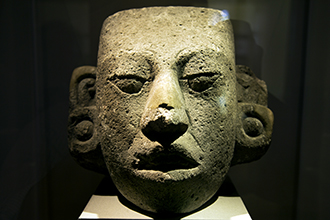Where have all the Maya gone?
Modern people often assume that ancient people stayed in one place. But that's not the case, says Marcello A. Canuto, director of the Middle American Research Institute (MARI) and associate professor of anthropology at Tulane University.

Maya objects, such as the one pictured here, tell invaluable stories of an ancient people but the excavation of such artifacts comes at a steep price. (Photo by Ryan Rivet)
The Tulane Maya Symposium & Workshop, “On the Maya Trail: Ancient Travelers, Epic Voyages,” (March 20â“23) is exploring the ways the ancient Maya moved across their landscape.
In its 11th year, the symposium, organized by MARI, has a rolling registration. Canuto expects more than 100 people will participate.
Karl Taube of the University of Californiaâ“Riverside gives the keynote talk, which is open to the public, on Mesoamerican art at 6 p.m. on Friday (March 21) at the New Orleans Museum of Art.
The collaboration with NOMA has added a new dimension to the symposium, says Canuto. “We are reaching the greater New Orleans community.”
Another highlight of the symposium is the screening of The Dance of the Maize God, a 2014 documentary. This event also is open to the public. The film will be shown in Freeman Auditorium of the Woldenberg Art Center at 4 p.m. on Saturday (March 22).
According to the symposium website, “Painted vases, looted from tombs, have opened an extraordinary window on the ancient Maya. But the race to unearth these treasures has resulted in vast destruction. Dance of the Maize God explores the royal life and rich mythology of the Maya, as well as the tangled issues surrounded the looted art.”
Canuto says, “It's about the devastation caused by the illegal excavation of Maya objects from the region.”
